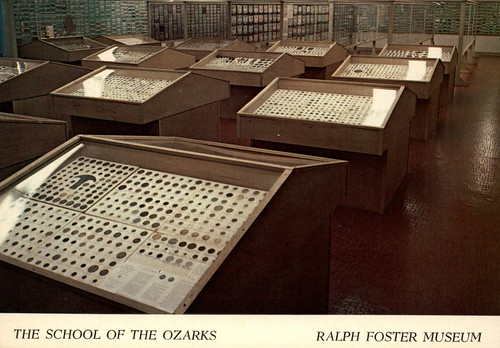
PREV ARTICLE
NEXT ARTICLE
FULL ISSUE
PREV FULL ISSUE
JOHN PAUL BUTLER (1920-1982)E-Sylum Feature Writer and American Numismatic Biographies author Pete Smith submitted this article on collector John Paul Butler and his exhibits at the Ralph Foster Museum at the College of the Ozarks. Thanks! -Editor I was not aware of this money museum until I started doing the research a couple of weeks back. This shows how a man of modest means can assemble a coin collection worthy of display in a museum.
John Paul Butler (1920-1982)
He attended Lambuth College in Jackson, Tennessee in 1939. His education was interrupted by his January 11, 1941, enlistment in the Army Air Corps during World War II. His enlistment papers show his civilian occupation as actor. After the war he attended the University of California and graduated from Pacific University. He remained in the service as an Air Force recruiter stationed at Jackson, Tennessee. His great-grandmother gave him a purse with five old coins when he was two years old. He began collecting coins seriously while stationed with the 15th Air Force in England during 1942. He was in a hospital recovering from an airplane crash and was visited by a British Air Force major who gave him some duplicates. He was transferred to Africa and continued to collect there. By the end of the war in 1945 he had accumulated more than 6,000 different coins. With limited funds, he acquired much of his collection through trades. Along the way he met and traded with Winston Churchill in England, King Farouk in Egypt and King Victor Emanuel III of Italy. He was apparently a shrewd and knowledgeable trader who often came out ahead with the trades. Butler became involved in politics in 1946. He ran for the district legislature but was defeated in a contest for the party nomination by 14 votes. There were allegations of election fraud. He was also defeated in the general election. He organized a meeting of veterans with the intention of forming a new national party. Out of that meeting came the Veterans' Non-Partisan League. He joined the ANA in 1952 as member 20399. He was a charter member of the West Tennessee Numismatic Society. Butler set up an exhibit of his collection for Coin Week in 1955. The collection was mounted in 16-inch-square display boards with more than 300 of these panels required. That year the West Tennessee Numismatic Society took second place in the ANA Coin Week competition. In the 1960's, Butler was reassigned to the 3750th Maintenance and Supply Group at Sheppard Air Force base in Texas. After retirement as a Master Sergent, he operated a grocery store in Humbolt, Tennessee, for five years. Butler claimed to have a Japanese coin struck in 2000 B.C. It was found in the rubble of an Asia Minor village. I wonder how that coin would be described today. Butler donated his coin collection to the Ralph Foster Museum at the College of the Ozarks at Point Lookout, Missouri, in 1966 and became curator of the collection in 1968. Well, not quite a donation. He sold the collection to Foster for $10 and Foster agreed to pay his salary as curator for life. In 1974, he took up the collection of cancelled checks from around the world. It was his hope to get a check from every bank in the world. In 1970 the collection was described as including 300,000 pieces of paper currency. Butler anticipated the development of digital banking and the eventual elimination of paper checks. In 1978 he estimated he had 25,000 checks. The collection was strong for checks from Missouri representing 3,000 banks from 490 communities. His oldest check was from the Bank of North America written in 1791. The largest check was a German inflationary piece in the amount of 500 billion Marks. In addition to cancelled personal checks, he was given some items like unredeemed company refund checks in small amounts. He had blank checks issued as fund raisers with the intention that donors would fill in the name of a bank and an amount.
On December 26, 1980, a thief unscrewed the top of a display case and removed 79 rare gold
coins from the Butler bought the Japanese gold coins from a cousin of Emperor Hirohito following World War II. Butler claimed it was the best collection of Japanese coins in the world. Museum staff said that it would be difficult for thieves to sell the coins without arousing suspicion. The weight was about ten pounds with a melt value around $100,000. The numismatic replacement value might be $1 million.
Butler was featured in articles for LIFE and LOOK Magazines. He acquired the title of Harry Waterson responded to my query:
The museum is closed now until January 17 for the winter break. We will see if we can learn the fate of the Butler collection next year. Thanks, Pete! A great story and life in collecting. What stories he could have told! -Editor
To read the earlier E-Sylum articles, see:
Wayne Homren, Editor The Numismatic Bibliomania Society is a non-profit organization promoting numismatic literature. See our web site at coinbooks.org. To submit items for publication in The E-Sylum, write to the Editor at this address: whomren@gmail.com To subscribe go to: https://my.binhost.com/lists/listinfo/esylum All Rights Reserved. NBS Home Page Contact the NBS webmaster 
|



